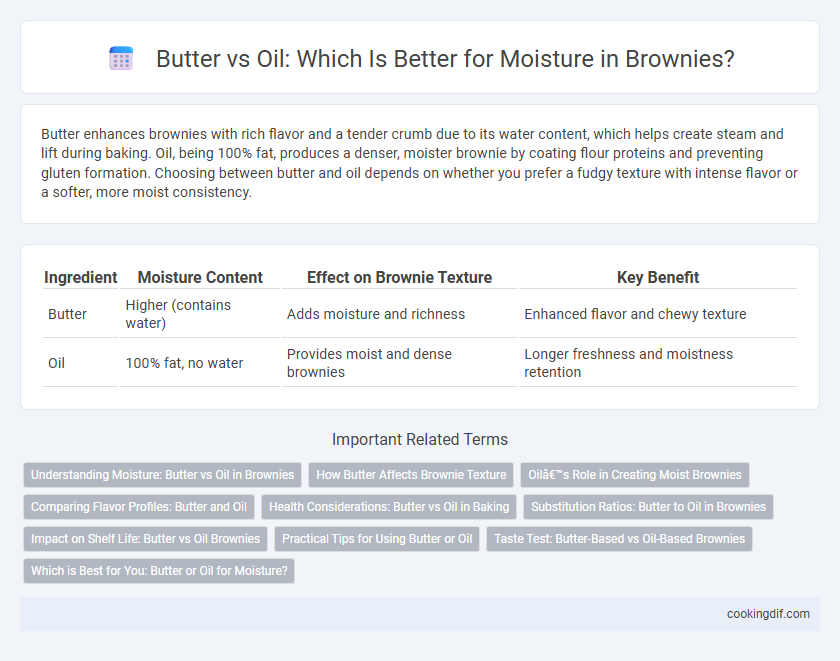Butter enhances brownies with rich flavor and a tender crumb due to its water content, which helps create steam and lift during baking. Oil, being 100% fat, produces a denser, moister brownie by coating flour proteins and preventing gluten formation. Choosing between butter and oil depends on whether you prefer a fudgy texture with intense flavor or a softer, more moist consistency.
Table of Comparison
| Ingredient | Moisture Content | Effect on Brownie Texture | Key Benefit |
|---|---|---|---|
| Butter | Higher (contains water) | Adds moisture and richness | Enhanced flavor and chewy texture |
| Oil | 100% fat, no water | Provides moist and dense brownies | Longer freshness and moistness retention |
Understanding Moisture: Butter vs Oil in Brownies
Butter and oil both contribute to moisture in brownies but affect texture differently; butter provides a richer flavor and slightly denser crumb due to its milk solids, while oil delivers a moister, more tender result by coating flour proteins and reducing gluten formation. Understanding the fat composition is crucial--oil's 100% fat content retains more moisture, resulting in a fudgier brownie. Choosing between butter and oil depends on desired brownie characteristics: buttery richness versus moist softness.
How Butter Affects Brownie Texture
Butter enhances brownie texture by providing a rich, tender crumb and slight crispness on the edges due to its milk solids. The water content in butter contributes to steam, creating a lighter, more aerated bite compared to oil-based recipes. Its fat structure helps produce a denser, fudgier consistency, which is often preferred in classic brownie recipes.
Oil’s Role in Creating Moist Brownies
Oil plays a crucial role in creating moist brownies by coating flour proteins, which inhibits gluten formation and results in a tender crumb. Unlike butter, oil remains liquid at room temperature, preserving moisture and preventing the brownies from drying out. This characteristic makes oil an ideal fat choice for brownies that require a consistently moist and soft texture.
Comparing Flavor Profiles: Butter and Oil
Butter imparts a rich, creamy flavor with a slightly nutty undertone that enhances the overall depth of brownies, creating a traditional and indulgent taste. Oil, being neutral, allows other ingredients like chocolate and vanilla to shine more prominently, resulting in a lighter, more streamlined flavor profile. Choosing between butter and oil depends on whether a dense, buttery richness or a moist, chocolate-forward brownie is desired.
Health Considerations: Butter vs Oil in Baking
Butter contains saturated fats and provides a rich flavor, but it also adds cholesterol and higher calories compared to oil. Oil, particularly vegetable or canola oil, is richer in unsaturated fats, which are considered heart-healthier and help maintain moisture in brownies without the density butter creates. Choosing oil over butter can reduce saturated fat intake, promoting better cardiovascular health while keeping brownies moist and tender.
Substitution Ratios: Butter to Oil in Brownies
Butter and oil both contribute to moisture in brownies but differ in texture and flavor; a common substitution ratio is using 3/4 cup of oil for every 1 cup of butter to maintain similar fat content and moisture levels. Using oil typically results in a denser, fudgier brownie texture, while butter imparts a richer flavor and slightly cakier crumb. Precise substitution ratios ensure balanced moisture retention and desired consistency in brownie recipes.
Impact on Shelf Life: Butter vs Oil Brownies
Butter-based brownies generally have a shorter shelf life due to higher moisture content and milk solids that can promote faster spoilage compared to oil-based brownies. Oil-infused brownies retain moisture longer, resulting in a softer texture and extended freshness, as oil is less prone to oxidation than butter. For prolonged storage, oil-based brownies are preferable, maintaining moistness and flavor stability over several days without refrigeration.
Practical Tips for Using Butter or Oil
Butter enhances brownie flavor and creates a tender crumb while oil offers greater moisture retention and a fudgier texture. For balanced results, substitute melted butter with an equal amount of oil to increase moistness without sacrificing taste. Use unsalted butter to control salt levels, and choose neutral oils like canola or vegetable for a subtle effect on flavor.
Taste Test: Butter-Based vs Oil-Based Brownies
Butter-based brownies deliver a rich, creamy flavor and a dense, fudgy texture favored in classic recipes. Oil-based brownies tend to be moister and softer, offering enhanced tenderness and a slightly lighter mouthfeel. Taste tests reveal that butter versions excel in flavor depth, while oil-based options provide superior moisture retention and a more delicate crumb.
Which is Best for You: Butter or Oil for Moisture?
Butter enhances brownies with a rich, creamy flavor and tender crumb due to its milk solids and water content, which promote moistness and chewiness during baking. Oil, being 100% fat, yields an ultra-moist, dense texture and longer shelf life by coating flour proteins more thoroughly and preventing gluten overdevelopment. Choosing butter suits those seeking flavor depth and a traditional texture, while oil is ideal for maximizing moisture and softness in brownies.
Butter vs Oil for Moisture in Brownie Infographic

 cookingdif.com
cookingdif.com